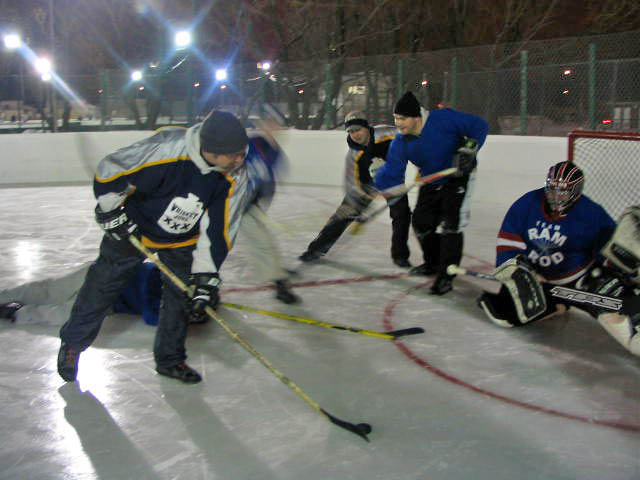SPONGE(E) HOCKEY
Sponge Hockey - Spongee is Hockey played on foot, not skates, using a standard Hockey stick, asponge puck, and soft soled footwear. Spongee takes the best of soccer, basketball, and ice Hockey in an effort to make it's unique brand of Hockey. A cult sport played almost exclusively in Winnipeg, Manitoba, Canada by thousands of players in dozens of leagues. It gets its name from the puck that is used: instead of the hard vulcanized rubber puck that is used in regular ice Hockey, a soft sponge puck is used.

It is generally played on outdoor rinks and differs from ice Hockey in a number of significant ways, the most important and obvious being that instead of skates, players wear soft-soled shoes. Broom ball shoes are normally used. Players generally do not wear helmets or padding, except for goalies. Some players wear volleyball knee pads, elbow pads and/or shin pads, Wearing slippery footwear on ice means that game play and strategy and skills are also different than those required in Hockey. There are usually two twenty-minute periods.
One of the original leagues was the Robertson League, named after its founder, John Robertson, who adapted Spongee Hockey and made sure that there is no contact involved. In spongee Hockey, icing occurs only the last three minutes of the game unless the winning team is shorthanded.

Hockey sticks must be safe and can only be used if said so by the referee. No spikes or tacks on the bottom of shoes, only soft-soled rubber shoes are allowed. Broom ball shoes are normally used. Players are not allowed to use any product on the soles of their shoes that would create greater grip on the ice. Goalies are allowed to wear anything necessary when playing their position. Helmets, masks and protective eye wear are recommended. Each team must have the same color uniform with a number written on the back that is visible. The captain must have the letter "C" on front of their jersey. There is only allowed one alternate and he/she has to be identified by the letter "A" on their jersey.
Rules
Only the captain and alternate may talk to the referee while the game is in session for any clarifications. The goalie must stay in their area, they are not allowed to go past the center.
There is absolutely no body checking or any form of physical contact allowed. A warning will be issued if a player has their Hockey stick above waist level.
The key is a 20' by 20' marked box in front of the net. A player may not stand in the opposition's key for longer than three seconds. Violations of the key are not called if the puck is in the key, if the offensive team does not have control of the puck, or if the puck is on the opposite side of center.
A double minor penalty is a result of six minutes, a minor penalty is a result of three minutes, a major penalty is also six minutes plus a free shot for the other team. Players may not go back and play on the ice unless they served their penalty fully. If one of the players receives three penalties, he/she will be taken out of the game. If a team receives seven penalties it results in a penalty shot for the opposing team. The player who was on the ice while the penalty was taking place will be able to take this shot.
All faceoffs when a penalty is called will go in the defensive zone of the team taking the penalty, except when there are coincidental penalties, then faceoff is at closest faceoff circle.
If the score is tied at the end of the game, they will have a five minute sudden victory. If the winner is still not determined there will be a shoot out. The first shooters must be different and will participate until a winner is determined. If a winner is still not determined, a one for one shoot out occurs. This means that after the first team shoots, the other team has to match it, or they will automatically lose.
HISTORY
Spongee is an adaptation of road Hockey. It originated in Winnipeg, Manitoba at River Heights Community Centre, probably in the 50's. Originally, a tennis ball was used, and players wore standard winter boots. The game's appeal was twofold. First, in very cold weather feet in skates are subject to frostbite, whereas boots allowed for much longer exposure. Second, skating skills were not required, so poor, or non-skaters could play. The spongee puck originated when someone took a red, white and blue ball and cut out the center, leaving a rude approximation of a standard Hockey puck.
